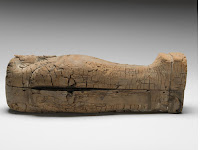One of Egypt's oldest pyramids King Unas reopens after 20-year closure
Minister of Antiquities Khaled El-Enany is inaugurating Thursday evening the opening of the pyramid of ancient Egyptian King Unas at the Saqqara necropolis after 20 years of its closing.
The pyramid of King Unas is the last pyramid of the 5th Dynasty. Despite its small size, it is considered as one of the most important Egyptian pyramids, as it is the first pyramid to record the "Pyramids Texts," which hold important religious significance on the resurrection of deceased kin.
Exhibition Season: Annual Archaeological Exhibitions in London, 1880s-1930s
Annual archaeological exhibitions were a visible symbol of archaeological research. Held mainly in London, the displays encapsulated a network of archaeologists, artists, architects and curators, and showcased the work of the first generations of trained archaeologists. The exhibition catalogues and published reviews of the displays provide a unique method for exploring the reception and sponsorship of archaeological work overseas and its promotion to a fascinated, well connected and well moneyed public.
The drawing is from Illustrated London News, September 20, 1890. A view into WMF Petrie's first exhibition of objects found at Lahun, Oxford Mansions, London, 1890.
Copying the Kings: Preserving Egypt’s Heritage for Generations to Come
Photo courtesy of Factum Arte
While the debate on the existence of a side-chamber in Tutankhamun’s tomb has been a hot topic in national and international news in recent months, few people realize that British artist Adam Lowe has created an exact facsimile of the young pharaoh’s burial chamber in the grounds of Howard Carter’s house on the West Bank in Luxor. Having visited the original many times, the precision of the replica is slightly unnerving.
 |
| Add caption |
A 3,800-year-old female Egyptian mummy found in the necropolis of Qubbet el-Hawa in southeastern Egypt is from the Middle Kingdom. The tomb belonged to a woman called “Lady Sattjeni,” one of the important personalities of the kingdom.
For some amazing photos, see this article and this one.
The meteoritic origin of Tutankhamun's iron dagger blade
An international research team (Politecnico di Milano, Università di Pisa, Egyptian Museum in Cairo, Italian National Research Council, University of Fayoum, Politecnico di Torino, XGLab Italian company) documents the meteoritic origin of the iron of the dagger blade belonging to the ancient Egyptian King Tutankhamun (14th C B.C.E). This solves a longstanding heated debate among scholars since its discovery in the wrapping of the king's mummy in 1925, by archaeologist Howard Carter.
Egyptian Papyri Found to Contain R-Rated Magic Spells
A pair of two 1,700-year-old Egyptian papyri, freshly-translated, have proven to be filled with the kind of premium cable television incantations that wouldn’t be out of place in an episode of “Game of Thrones.”
EgyptAir on the Great Pyramid
CAIRO: The Giza pyramids were illuminated with the logo of EgyptAir on Saturday night in solidarity with the victims of the national carrier’s passenger plane that crashed over the Mediterranean last week, Youm7 reported.
Picture of the Week
\Hippolyte Délié and Emile Béchard - Statuettes of Egyptian Deities, 1871-72
Identified items shown in this image:
115 - Memphis- Saqqarah - Isis as Mother
132 - Memphis- Grandes Pyramides - Head of Anubis
225 - Memphis- Saqqarah - Osiris-Aah
240 - Memphis- Saqqarah - Harpocrate
241 - Memphis- Saqqarah - Harpocrate
251 - Memphis- Grandes Pyramides - Osiris seated
252 - Memphis- Grandes Pyramides - Osiris seated
(from Mariette, "Notice des Principaux Monuments..." 1872)
via The History of Photography Archive at http://bit.ly/27PGOIc















































